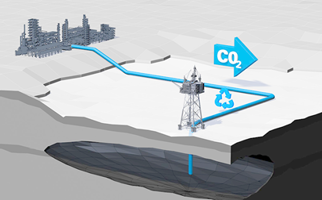
With over 180 technologies reported, and 40% of these in the Development or Early Deployment stage, Reservoir & Well Management is a very active and innovative area in the UKCS technology space.
In 2024, Operators reported new technologies focusing on improved recovery, reservoir monitoring, and improved well surveillance. These included remote/remedial well surveillance and monitoring of gas flow rate using AI based volume quantification of bubble flow count, management and intervention technologies such as tubing retrievable/retrofit SSSVs, storm chokes for HPHT wells, and water shutoff annular isolation technologies.
Technologies for carbon storage operations are increasing, and hydrogen technologies are reported for the first time this year.
There has been a high-degree of deployment in the field, thanks to partnerships between Operators and suppliers in applying these solutions to specific requirements.
- The main areas of Operators’ technology focus are on improved recovery, intelligent reservoir monitoring, well surveillance, management and intervention. The number of technologies for carbon storage operations is increasing and hydrogen technologies are reported for the first time this year
- There is widespread interest in these technologies, with 12 Operators carrying at least 5 Reservoir and Well Management technologies in their plans, 25 operators are reporting at least 1 technology
There is a balanced mix of technologies at all stages of development in this area, with circa 38% of these being in the deployment stages
Operators rely on vendors to source the majority of technologies, but in circa 37% of the cases participate in technology development directly and/or in partnership
Readiness definitions: Early Development (TRL 1-4), Late Development/Pilot (TRL 5-7), Early commercialisation (TRL 8), Proven (TRL 9)
Increased adoption of downhole fibre optic sensing for temperature, pressure and vertical seismic profiling. Wireless downhole pressure gauges also reported. Emerging technology includes; virtual metering; geological case for CCS in depleted SNS gas fields; and smart monitoring for ESPs. New this year are endpoint detection response; remote/remedial well surveillance; and monitoring of gas flow rate using AI based volume quantification of bubble flow count.
- EDR (end point detection response) - Associated with MDR [Managed Detection and Response] and DFIR [Digital Forensic and Incident Response] this service makes the endpoints more secure and enables safer operations.
- TRL 9 Commercially available
- Remote/Remedial Well Surveillance - Assesses the application of instrumented wellhead equipment including VR transmitters and wireless downhole instrumentation.
- TRL 9 Commercially available
- DAS (Distributed Acoustic Sensing) uses fibre optic technology in a number of new reservoir sensing methods - The Disposable FLI system uses fibre-optic technology to capture distributed temperature and acoustic measurements along the entire length of the well in real time.
- TRL 9 Commercially available
WellSense system uses dis-solvable coated fibre lines attached to a disposable sensing tool The FLI probe and fibre are single-use and sacrificial so can be left in the well at the end of the survey
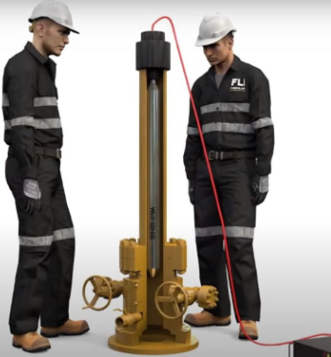
- Wireless Bottom Hole Pressure Gauges - Downhole pressure monitoring to determine scale deposition at an early stage to mobilize a water wash of the well, also to evaluate salt scaling to optimize waterwash frequency.
- TRL 9 Commercially available
| Technology Example: | |
|---|---|
|
Example of this technology from Schlumberger using “Signature gauges” enabled by Muzic acoustic telemetry this technology enables constant communication with the gauges. |
|
- Smart monitoring for ESP (Electrical Submersible Pumps) - Condition based monitoring and automatic optimisation of ESP (Electrical Submersible Pump) wells.
- TRL 9 Commercially available
- AI volume quantification - In-house development to monitor gas flow rate by quantification of bubble flow count for leak monitoring
- TRL 8 Early Commercialisation
- Virtual metering - Using Machine Learning for virtual metering and operational envelopes
- TRL 5-7 Late Development/Pilot
- CCS - Collaboration with NZTC on Evaluating the Geological Case for CO2 storage in Depleted Gas Fields. CCS Feasibility study for Operators asset being carried out in house in 2022.
- TRL 1-4 Early Development
An increase in artificial lift technologies including ESPs and gas lift, with a focus on retrofit devices and alternatively conveyed methods, advanced well modelling, ensemble-based reservoir modelling & downhole compression. New this year are inversion resistivity tools; intelligent well technology; and a slim pump safety valve. Emerging technologies include; microgel water shut off; and jetted deep-penetrating perforation.
- Slim Pump Safety Valve (SPSV) - Can be incorporated into cable deployed ESPs or jet pump systems providing an API qualified valve with minimal additional system complexity.
- TRL 9 Commercially available
- Organic Oil Recovery planning / lab analysis - Enhanced oil recovery by activating in-situ microbes that reduce interfacial tension between water and oil, breaking down trapped oil into smaller droplets that can be transported through the reservoir.
- TRL 9 Commercially available
- Reservoir Modelling - Geological modelling of hydrogen within a storage reservoir
- TRL 9 Commercially available
- Through tubing Gas lift system – In depleted field with lack of motive power to produce, Through Tubing installation to surface with new approaches to utilising the SSSV Proprietary Gas lift system
- TRL 9 Commercially available
- Alternate Conveyed ESPs/Slimline ESPs – Remedial ESPs deployed by coil/cable, Investigation and field trial of alternate deployed (e.g. coil/cable), remedial ESP systems, alternate motors (e.g. permanent magnetic)
- TRL 9 Commercially available
The thru-tubing ESP is deployed through a surface lubricator and lowered inside the existing production tubing. Easily retrieved using only the cable.
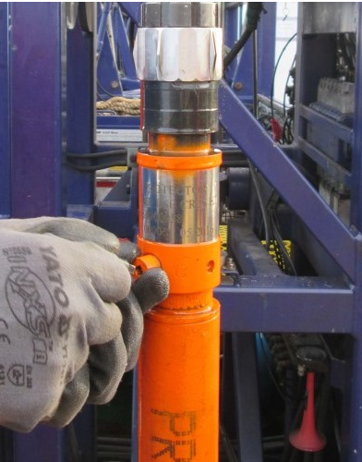
- Geosteering - Use of inversion resistivity tools to geosteer in unswept reservoir zones and image moved contacts in adjacent zones
- TRL 8 Early Commercialisation
- Ensemble-based reservoir modelling - Employed ensemble-based reservoir modelling to build an ensemble of forecast models to drive improved field management and field development decision making.
- TRL 9 Commercially available
- Downhole Compression - Maximising recovery from old gas fields and weaker wells is proving an increasing challenge as the field ages. The conventional methods of dropping the topsides separators pressures only get so far and then using surfactants to lift liquid loaded wells, also has limits and eventually least to COP from the well.
- TRL 5-7 Late Development/Pilot
- Water Shut-off and Conformance Control – Use of pre-gelled polymer for water shutoff and conformance control.
- TRL 1-4 Early Development
- Jetted deep-penetrating perforation - Assessing possible test of jetted 'blood vessel' extended perforations through NZTC collaboration
- TRL 1-4 Early Development
Operators are adopting technologies for improving well access for interventions and low-cost workover rigs to reduce the costs; puncher/cutter multifunction wireline tools; and real time coiled tubing. New this year is the ultra-high expansion plug for zonal isolation; real time slickline removing the need for e-line wireline equipment; and a lightweight coil hose circulation system.
- Ultra High Expansion Plug - Flexible zonal isolation solution which can be run in flowing wells and set as a platform for cement to be deposited once pressure and flow have abated.
- TRL 9 Commercially available
- Use of real time slickline to save both time and cost by removing the need for e-line wireline equipment
- TRL 9 Commercially available
- Coil Hose - Deployment of light weight circulation system to provide a lower cost more efficient alternative to traditional coiled tubing systems.
- TRL 9 Commercially available
- Puncher / Cutter - slickline deployed cutter and stroker. Puncher and cutter can be deployed in a single string
- TRL 9 Commercially available
- WireLine Mast is designed to improve wireline mast operations on fixed offshore installations. It improves access, rigging time and safety for personnel – enabling safe and efficient wireline operations.
- TRL 9 Commercially available
| Technology Example: | |
|---|---|
|
The new 90’ LynxTM Wire Line Mast is setting a new industry standard. Introducing superior efficiency, increased working environment and without the need for external cranes once installed. Also features BOP access in compliance with Norsok S-002. |
 |
- lightweight wireline system, - Full wireline spread takes minimum 6 POB, typically 48 hours+ to rig up and ~24 hours to move between wells. This puts strain on platform schedule/manning the system is lightweight, unitized and designed for minimum rig up/down time.
- TRL 9 Commercially available
- Real Time Coiled Tubing - Real Time data acquisition during CT operations for data collection and monitoring as well as downhole equipment activation (Perforating Guns) during live well interventions.slickline deployed cutter and stroker. Puncher and cutter can be deployed in a single string
- TRL 9 Commercially available
Digital Slickline was selected for a pre-abandonment phase of nine wells (versus a sequential slickline and electric line operation). Provided real-time quality control and datadriven decisions across the entire operation.

- Flow Assurance Module (FAM) – A valve manifold module fixed on the annulus side of the Xmas tree to allow injecting scale inhibitor down to the well without breaking tree cap. This allowed the operators FPSO to use ROVSV rather than LWIV for scale squeeze with less intervention days.
- TRL 5-7 Late Development/Pilot
Well integrity repairs continue to show strong innovation in providing solutions for wellhead leakages; tracking well leak paths; tubing retrievable/retrofit SSSVs; storm chokes for HPHT wells; water shutoff annular isolation technologies; swellable seals; and slim pump safety valves. Emerging technology includes DHSV control line remediation by nano coil. New this year are heated flushing and re-greasing of tree valves and gas ingress isolation valves.
- Heated flushing and re-greasing of tree valves - Where valves could not be re-instated by standard remediation procedures. Following the flushing exercise, all valves successfully met the performance criteria, the majority with zero leak rates.
- TRL 9 Commercially available
- Gas Ingress isolation valve - used when getting gas returns up control line of downhole SSSV. GIIV prevents gas returning to hydraulic panel by holding positive pressure.
- TRL 9 Commercially available
- Novel wellhead sealing for production wells due to integrity issues - A time activated sealant is deployed in its liquid phase into the voids of wellhead sealing areas. Once in place, the sealant converts to a resilient, self-bonding and pressure-energized solid material.
- TRL 9 Commercially available
- HPHT Storm Choke - Pressure dependent valve to replace failed SSSV operation
- TRL 9 Commercially available
- Swellable seals - swellable seals used when gas influx is seen in wireline retrievable SSSV control line. Polished bore of safety valve landing nipple can be damaged and this seal swells in oil or water, creating a seal in the damaged area
- TRL 9 Commercially available
- Slim Pump Safety Valve (SPSV) - The Slim Pump Safety Valve can be incorporated into Cable Deployed ESP's or Jet Pump Systems, providing an API qualified valve with minimal additional system complexity.
- TRL 9 Early Commercialisation
- TRL 9 Early Commercialisation
- Electronic Ambient Valve (EAV) - In wells with an inoperable DHSV that require a replacement to be brought online where a normal DHSV cannot be used. E.g. control line issues, access issues etc.
- TRL 8 early Commercialisation
- TRL 8 early Commercialisation
- Wireless Downhole Safety Valve - retrievable wireless subsurface safety valve system helps operators restore wells and resume production after SSSVfailure in – producing and injection wells.
- TRL 8 Early Commercialisation
SLB – Wireless Downhole Safety Valve : wells that require remediation after a (TR-SSSV) failure, or wells originally completed without a subsurface safety valve and now requiring one due changes in policies or regulations
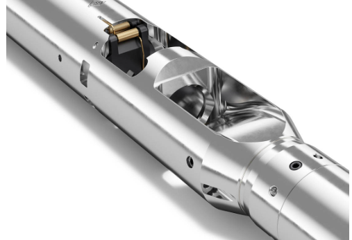
- DHSV Control line remediation - DHSV control lines run behind the tubing in a well - but can be a direct conduit to the reservoir if barrier failures occur. Repairs of these can be completed using sealant for low rate leaks, however other currently unable to resolve intrusive issues for deployment into DHSV control lines.
- TRL 5-7 Late Development/Pilot
This sub-category includes deployable technologies using mechanical, radio frequency signals & electro-hydraulic pulsing technologies. Emerging technology includes use of kinetic hydrate inhibitors; and innovative solutions to inhibit and soften wax and asphaltenes. New this year are an automated water washing package for halite removal and a digital electro-hydraulic scale milling technique
- Installation of automated water washing package - Enables remote water washing of wells to remove halite. Managed from the control room onshore
- TRL 9 Commercially available
- Extended Release platform - Leverages a nanotechnology platform to significantly increase production chemical performance while providing a meaningful carbon reduction advantage.
- TRL 9 Commercially available
- Digital electro-hydraulic intervention technology - To provide an effective e-line scale milling alternative to coiled tubing for small platforms
- TRL 9 Commercially available
- Innovative wax Inhibitor and dissolver - green carbon electron sharing technology that weakens the Van der Waals attractive forces for Asphaltenes and paraffins allowing a phase change from solid to liquid that effectively controls waxes and asphaltenes at a lower dosage rate both inhibits and dissolves wax
- TRL 9 Commercially available
- Exothermic reactive chemical - wax dissolver - This is an exothermic reactive chemical upon mixing of organic acid and base at certain ratios to achieve temp required to dissolve wax
- TRL 9 Commercially available
- Rotating tool Technology - A mechanical scale prevention tool developed for Scale Protection. It prevents scale from growing across the safety.
- TRL 9 Commercially available
- TRL 9 Commercially available
- Scale build inhibitor - is a surface mounted scale control technology which transmits radio frequency signals along production tubing.
- TRL 9 Commercially available
- Wireline deployed scale removal tool - Wireline deployed high pulse tool for scale removal and production stimulation using Electro-Hydraulic Pulsing (EHP) principles
- TRL 9 Commercially available
Bluespark WASP - Wireline deployed high pulse tool for scale removal and production stimulation
Technology example link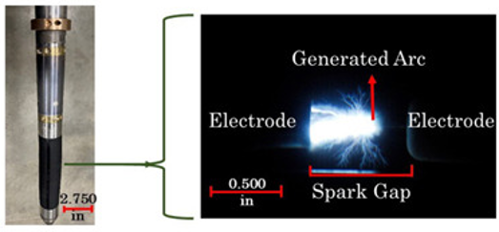
- Kinetic Hydrate Inhibitor’s- Prevents the creation of hydrates - allowing for better flow along the pipeline - Kinetic hydrate inhibitors (KHIs) interfere with hydrate crystal growth or nucleation by embedding themselves into the lattice structure, delaying significant growth for longer than the fluid’s residence time
- TRL 5-7 Late Development/Pilot
This sub-category includes a range of new products to improve flow and trace the production geology of reservoirs. Emerging technologies include improving well water and liner shut off, together with rejuvenation techniques for shut in wells and water shutoff by annular isolation technologies and expanding polymer grains. New this year is offshore slop treatment using ceramic membranes
- Offshore slop treatment - To minimise transport and tank cleaning costs. Also reduces confined space work and onshore treatment. The contaminated fluids are run through ceramic membranes which separate oil from water to produce clean fluids
- TRL 9 Proven Technologies
- Rejuvenation of shut-in wells - wells are shut-in due to liquid loading or sand/proppant fill. A well was restarted successfully by controlling the drawdown of the formation to avoid water coning
- TRL 9 Proven Technologies
- Water tracers - Allowing identification of open perforations and also the early identification of water breakthrough from individual zones –
- TRL 9 Proven Technologies
- Water Shut Off – Bismuth based or epoxy resin based Isolation Technologies.
- TRL 9 Proven Technologies
- Drag Reducing Agent (DRA) injected into seawater stream to increase water injection volumes
- TRL 9 Proven Technologies
- Expanding Polymer Grain Pumped into the reservoir to make it expand and fully block permeability, it provides a barrier to barrier, self- healing seal surrounding the wellbore.
- TRL 5-7 Late Development/Pilot
Resolute Expanding Polymer Grain Pumped into the reservoir to make it expand and fully block permeability, it provides a barrier to barrier, self-healing seal surrounding the wellbore. It blocks perforations, screens & bore space providing a self-healing pre-barrier to plugs and cement
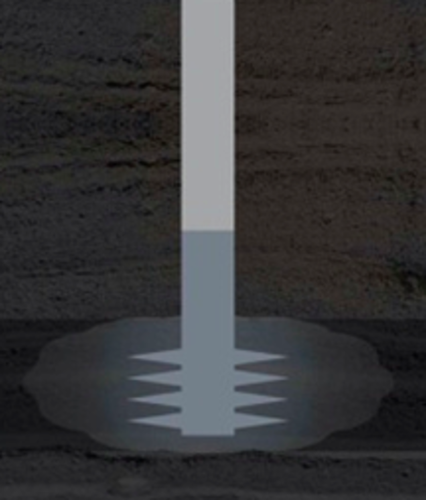
- Horizontal Well water shut off - A study showed the most applicable technologies to use are mechanical plugs to achieve a seal in the wellbore and highly thixotropic polymer gels to achieve a seal in the annulus
- TRL 1-4 Early development
- Deployment of snorkel on wireline - Design of different connector to allow deployment of snorkel on wireline rather than coil
- TRL 5-7 Late Development/Pilot
Sands & Solids Management sub-category reported technologies including retrofittable downhole sand screens, porous foam and oil-based gravel packing. Emerging technologies include low-cost sand control completions and EHS screens. No new technologies reported in this sub-category.
- Dual string perforating and retrofitting downhole sand screens - Interventions in two wells during 2020 to shut-off water from the lower reservoir, and access attic oil behind the production casing. The latest perforating technology was tested to achieve the required penetrations of the tubing and production casing set across the upper reservoir section. Downhole sand control using ceramic will be deployed - as conventional steel screens would likely be cut by the velocity of production through the perforated tubing/casing.
- TRL 9 Commercially available
- Porous foam that set around liner for sand control
- TRL 9 Commercially available
- Oil Based (NAF) Gravel Packing - Increased productivity in low net to gross reservoirs
- TRL 9 Commercially available
- Reliable low-cost sand control completion - Evaluate alternative sand control completion designs that are reliable and maintain recovery, enable the development of reservoir targets that are marginal currently - maximise economic recovery, extend field life.
- TRL 5-7 Late Development Pilot
- Endurance Hydraulic Screen Solution - New screen filter development for EHS solution that will enhance screen productivity
- TRL 1-4 Early development









